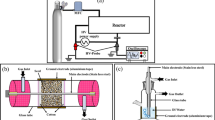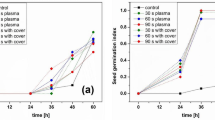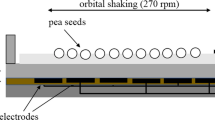Abstract
Seed priming is a pre-treatment of seeds leading to the improvement of their germination, the plant growth, and the product yield. In this study we investigated the possibility of the use of non-thermal plasma operating in atmospheric pressure air for seed priming with the objective to improve the yield of pea seeds. Two priming ways were used: an indirect way by using plasma activated water (PAW) generated by the transient spark discharge with water electrospray or the glow discharge batch treatment and a direct exposure of seeds to the pulsed corona discharge. After treatment, the seeds were planted in the outdoor field for about 14 weeks until harvest. The direct plasma treatment resulted in two key results: the strong effectiveness of the pulsed corona plasma improving the yield, and the long-term effect of the plasma seed treatment. The results of the indirect treatment showed that the pea plants from the seeds primed using PAW gained some improved growth parameters, especially the number of seeds per pod and the total number of seeds per plant. The scanning electron microscopy analysis showed that PAW and direct treatment induced some morphology changes at the surface of the pea seeds. This study documents a long-term effect of non-thermal plasma seed priming and contributes to the plasma agriculture applications by suggesting the implementation of non-thermal plasma direct or indirect treatments into the field.


















Similar content being viewed by others
References
FAO (2009) How to feed the world in 2050. https://www.fao.org/3/ak542e/ak542e00.htm. Accessed from19 Jan 2022
Waqas M, Korres NE, Khan MD et al (2019) Advances in the concept and methods of seed priming. In: Hasanuzzaman M, Fotopoulos V (eds) Priming and pretreatment of seeds and seedlings: implication in plant stress tolerance and enhancing productivity in crop plants. Springer, Singapore, pp 11–41
Lutts S, Benincasa P, Wojtyla L et al (2016) Seed priming: new comprehensive approaches for an old empirical technique. In: Araujo S, Balestrazzi A (eds) new challenges in seed biology - basic and translational research driving seed technology. InTech, Vienna
Paparella S, Araújo SS, Rossi G et al (2015) Seed priming: state of the art and new perspectives. Plant Cell Rep 34:1281–1293. https://doi.org/10.1007/s00299-015-1784-y
Garcia D, Arif S, Zhao Y, et al (2021) Seed priming technology as a key strategy to increase crop plant production under adverse environmental conditions. https://doi.org/10.20944/preprints202109.0364.v1
Hussain S, Khan F, Hussain HA, Nie L (2016) Physiological and biochemical mechanisms of seed priming-induced chilling tolerance in rice cultivars. Front Plant Sci. https://doi.org/10.3389/fpls.2016.00116
Shah T, Latif S, Khan H et al (2019) Ascorbic acid priming enhances seed germination and seedling growth of winter wheat under low temperature due to late sowing in Pakistan. Agronomy 9:757. https://doi.org/10.3390/agronomy9110757
Varier A, Vari AK, Dadlani M (2010) The subcellular basis of seed priming. Curr Sci 99:450–456
Marthandan V, Geetha R, Kumutha K et al (2020) Seed priming: a feasible strategy to enhance drought tolerance in crop plants. Int J Mol Sci 21:8258. https://doi.org/10.3390/ijms21218258
Al-Baldawi M, Hamza J (2017) Seed priming effect on field emergence and grain yield in sorghum. J Cent Eur Agric 18:404–423. https://doi.org/10.5513/JCEA01/18.2.1915
Rakshit A, Singh HB (2018) Advances in seed priming. Springer, Singapore
Chatterjee N, Sarkar D, Sankar A et al (2018) On-farm seed priming interventions in agronomic crops. Acta Agric Slov 111:715. https://doi.org/10.14720/aas.2018.111.3.19
Singh A, Jatav AL, Singh P, et al (2017) Effect of seed priming treatments on seed quality parameters and storability of field pea (Pisum sativum L.). J Pharmacogn Phytochem 6:161–163
Araujo SDS, Paparella S, Dondi D et al (2016) Physical methods for seed invigoration: advantages and challenges in seed technology. Front Plant Sci 7:646
Shine MB, Guruprasad KN, Anand A (2011) Enhancement of germination, growth, and photosynthesis in soybean by pre-treatment of seeds with magnetic field. Bioelectromagnetics 32(6):474–484. https://doi.org/10.1002/bem.20656
Bukhari SA, Tanveer M, Mustafa G, Zia-Ud-Den N (2021) Magnetic field stimulation effect on germination and antioxidant activities of Presown hybrid seeds of sunflower and its seedlings. J Food Qual 2021:e5594183. https://doi.org/10.1155/2021/5594183
Talei D, Valdiani A, Maziah M, Mohsenkhah M (2013) Germination response of MR 219 rice variety to different exposure times and periods of 2450 MHz microwave frequency. Sci World J 2013:e408026. https://doi.org/10.1155/2013/408026
El-Sanatawy AM, El-Kholy ASM, Ali MMA et al (2021) Maize seedling establishment, grain yield and crop water productivity response to seed priming and irrigation management in a Mediterranean arid environment. Agronomy 11:756. https://doi.org/10.3390/agronomy11040756
Damalas CA, Koutroubas SD, Fotiadis S (2019) Hydro-priming effects on seed germination and field performance of faba bean in spring sowing. Agriculture 9:201. https://doi.org/10.3390/agriculture9090201
Adhikari B, Dhital PR, Ranabhat S, Poudel H (2021) Effect of seed hydro-priming durations on germination and seedling growth of bitter gourd (Momordica charantia). PLoS ONE 16:e0255258. https://doi.org/10.1371/journal.pone.0255258
Moradi A, Younesi O (2009) Effects of osmo- and hydro-priming on seed parameters of grain sorghum (Sorghum bicolor L.). Aust J Basic Appl Sci 3:1696–1700
Tizazu Y, Ayalew D, Terefe G, Assefa F (2019) Evaluation of seed priming and coating on germination and early seedling growth of sesame (Sesamum indicum L.) under laboratory condition at Gondar, Ethiopia. Cogent Food Agric 5:1609252. https://doi.org/10.1080/23311932.2019.1609252
Anosheh HP, Sadeghi H, Emam Y (2011) Chemical priming with urea and KNO3 enhances maize hybrids (Zea mays L.) seed viability under abiotic stress. J Crop Sci Biotechnol 14:289–295. https://doi.org/10.1007/s12892-011-0039-x
Lizárraga-Paulín E-G, Miranda-Castro S-P, Moreno-Martínez E et al (2013) Maize seed coatings and seedling sprayings with chitosan and hydrogen peroxide: their influence on some phenological and biochemical behaviors. J Zhejiang Univ Sci B 14:87–96. https://doi.org/10.1631/jzus.B1200270
Shrestha A, Pradhan S, Shrestha J, Subedi M (2019) Role of seed priming in improving seed germination and seedling growth of maize (Zea mays L.) under rain fed condition. J Agric Nat Resour 2:265–273. https://doi.org/10.3126/janr.v2i1.26088
Jira-Anunkul W, Pattanagul W (2020) Seed priming with hydrogen peroxide alleviates the effects of drought stress in rice (Oryza sativa L.) seedlings. Not Bot Horti Agrobot Cluj-Napoca 48:273–283. https://doi.org/10.15835/nbha48111829
Hemalatha G, Renugadevi J, Eevera T (2017) Studies on seed priming with hydrogen peroxide for mitigating salt stress in rice. Int J Curr Microbiol Appl Sci 6:691–695. https://doi.org/10.20546/ijcmas.2017.606.081
Barba-Espín G, Hernández JA, Diaz-Vivancos P (2012) Role of H2O2 in pea seed germination. Plant Signal Behav 7:193–195. https://doi.org/10.4161/psb.18881
El-Sanatawy AM, Ash-Shormillesy SMAI, Qabil N et al (2021) Seed halo-priming improves seedling Vigor, grain yield, and water use efficiency of maize under varying irrigation regimes. Water 13:2115. https://doi.org/10.3390/w13152115
Ruttanaruangboworn A, Chanprasert W, Tobunluepop P, Onwimol D (2017) Effect of seed priming with different concentrations of potassium nitrate on the pattern of seed imbibition and germination of rice ( Oryza sativa L.). J Integr Agric 16:605–613. https://doi.org/10.1016/S2095-3119(16)61441-7
Moaaz Ali M, Javed T, Mauro RP et al (2020) Effect of seed priming with potassium nitrate on the performance of tomato. Agriculture 10:498. https://doi.org/10.3390/agriculture10110498
Laroussi M (2002) Nonthermal decontamination of biological media by atmospheric-pressure plasmas: review, analysis, and prospects. IEEE Trans Plasma Sci 30:1409–1415. https://doi.org/10.1109/TPS.2002.804220
Bruggeman PJ, Kushner MJ, Locke BR et al (2016) Plasma–liquid interactions: a review and roadmap. Plasma Sources Sci Technol 25:053002. https://doi.org/10.1088/0963-0252/25/5/053002
Khlyustova A, Labay C, Machala Z et al (2019) Important parameters in plasma jets for the production of RONS in liquids for plasma medicine: a brief review. Front Chem Sci Eng 13:238–252. https://doi.org/10.1007/s11705-019-1801-8
Rathore V, Tiwari BS, Nema SK (2021) Treatment of pea seeds with plasma activated water to enhance germination, plant growth, and plant composition. Plasma Chem Plasma Process. https://doi.org/10.1007/s11090-021-10211-5
Junior CA, de Menezes FLG, Vitoriano JDO, da Silva DLS (2019) Effect of plasma-activated water on soaking, germination, and Vigor of erythrina velutina Seeds. Plasma Med 9(2):111–120. https://doi.org/10.1615/PlasmaMed.2019031667
Terebun P, Kwiatkowski M, Hensel K et al (2021) Influence of plasma activated water generated in a gliding arc discharge reactor on germination of beetroot and carrot seeds. Appl Sci 11:6164. https://doi.org/10.3390/app11136164
Pawlat J, Starek A, Sujak A et al (2018) Effects of atmospheric pressure plasma generated in GlidArc reactor on Lavatera thuringiaca L. seeds’ germination. Plasma Process Polym 15:1700064. https://doi.org/10.1002/ppap.201700064
Jiang J, He X, Li L et al (2014) Effect of cold plasma treatment on seed germination and growth of wheat. Plasma Sci Technol 16:54–58. https://doi.org/10.1088/1009-0630/16/1/12
Saberi M, Modarres-Sanavy SAM, Zare R, Ghomi H (2018) Amelioration of photosynthesis and quality of wheat under non-thermal radio frequency plasma treatment. Sci Rep. https://doi.org/10.1038/s41598-018-30200-7
Brust H, Nishime TMC, Wannicke N et al (2021) A medium-scale volume dielectric barrier discharge system for short-term treatment of cereal seeds indicates improved germination performance with long-term effects. J Appl Phys 129:044904. https://doi.org/10.1063/5.0033369
Šerá B, Gajdová I, Šerý M, Špatenka P (2013) New physicochemical treatment method of poppy seeds for agriculture and food industries. Plasma Sci Technol 15:935–938. https://doi.org/10.1088/1009-0630/15/9/19
Abedi S, Iranbakhsh A, Oraghi Ardebili Z, Ebadi M (2020) Seed priming with cold plasma improved early growth, flowering, and protection of Cichorium intybus against selenium nanoparticle. J Theor Appl Phys 14:113–119. https://doi.org/10.1007/s40094-020-00371-8
Rasooli Z, Barzin G, Mahabadi TD, Entezari M (2021) Stimulating effects of cold plasma seed priming on germination and seedling growth of cumin plant. South Afr J Bot 142:106–113. https://doi.org/10.1016/j.sajb.2021.06.025
Nishime TMC, Wannicke N, Horn S et al (2020) A coaxial dielectric barrier discharge reactor for treatment of winter wheat seeds. Appl Sci 10:7133. https://doi.org/10.3390/app10207133
Mildaziene V, Pauzaite G, Naucienė Z et al (2018) Pre-sowing seed treatment with cold plasma and electromagnetic field increases secondary metabolite content in purple coneflower ( Echinacea purpurea ) leaves. Plasma Process Polym 15:1700059. https://doi.org/10.1002/ppap.201700059
Bußler S, Herppich WB, Neugart S et al (2015) Impact of cold atmospheric pressure plasma on physiology and flavonol glycoside profile of peas (Pisum sativum ‘Salamanca’). Food Res Int 76:132–141. https://doi.org/10.1016/j.foodres.2015.03.045
Stolárik T, Henselová M, Martinka M et al (2015) Effect of low-temperature plasma on the structure of seeds, growth and metabolism of endogenous phytohormones in pea (Pisum sativum L.). Plasma Chem Plasma Process 35:659–676. https://doi.org/10.1007/s11090-015-9627-8
Pauzaite G, Malakauskiene A, Nauciene Z et al (2018) Changes in Norway spruce germination and growth induced by pre-sowing seed treatment with cold plasma and electromagnetic field: short-term versus long-term effects. Plasma Process Polym 15:1700068. https://doi.org/10.1002/ppap.201700068
Dufour T, Gutierrez Q, Bailly C (2021) Sustainable improvement of seeds vigor using dry atmospheric plasma priming: evidence through coating wettability, water uptake, and plasma reactive chemistry. J Appl Phys 129:084902. https://doi.org/10.1063/5.0037247
Šerý M, Zahoranová A, Kerdík A, Šerá B (2020) Seed germination of black pine (Pinus nigra Arnold) after diffuse coplanar surface barrier discharge plasma treatment. IEEE Trans Plasma Sci 48:939–945. https://doi.org/10.1109/TPS.2020.2981600
Kostoláni D, Ndiffo Yemeli GB, Švubová R et al (2021) Physiological responses of young pea and barley seedlings to plasma-activated water. Plants 10:1750. https://doi.org/10.3390/plants10081750
Ndiffo Yemeli GB, Švubová R, Kostolani D et al (2021) The effect of water activated by nonthermal air plasma on the growth of farm plants: case of maize and barley. Plasma Process Polym 18:2000205. https://doi.org/10.1002/ppap.202000205
Sarangapani C, Scally L, Gulan M, Cullen PJ (2020) Dissipation of pesticide residues on grapes and strawberries using plasma-activated water. Food Bioprocess Technol 13:1728–1741. https://doi.org/10.1007/s11947-020-02515-9
Keller-Rudek H, Moortgat GK, Sander R, Sörensen R (2013) The MPI-Mainz UV/VIS spectral atlas of gaseous molecules of atmospheric interest. Earth Syst Sci Data 5:365–373. https://doi.org/10.5194/essd-5-365-2013
Laux CO, Spence TG, Kruger CH, Zare RN (2003) Optical diagnostics of atmospheric pressure air plasmas. Plasma Sources Sci Technol 12:125–138. https://doi.org/10.1088/0963-0252/12/2/301
Laux CO. (2002). Radiation and Nonequilibrium Collisional-Radiative Models, von Karman Institute Lecture Series 2002-07, Physico-Chemical Modeling of High Enthalpy and Plasma Flows, eds. D. Fletcher, J. M. Charbonnier, GSR Sarma, and T. Magin, Rhode-Saint-Genèse, Belgium.
Morrow R, Lowke JJ (1997) Streamer propagation in air. J Phys Appl Phys 30:614–627. https://doi.org/10.1088/0022-3727/30/4/017
Kulikovsky AA (1998) Analytical model of positive streamer in weak field in air: application to plasma chemical calculations. IEEE Trans Plasma Sci 26:1339–1346. https://doi.org/10.1109/27.725167
Capitelli M, Ferreira CM, Gordiets BF, Osipov AI (2013) Plasma kinetics in atmospheric gases. Springer Science & Business Media, New York
Machala Z, Janda M, Hensel K et al (2007) Emission spectroscopy of atmospheric pressure plasmas for bio-medical and environmental applications. J Mol Spectrosc 243:194–201. https://doi.org/10.1016/j.jms.2007.03.001
Scally L, Gulan M, Weigang L et al (2018) Significance of a non-thermal plasma treatment on LDPE biodegradation with pseudomonas Aeruginosa. Materials 11:1925. https://doi.org/10.3390/ma11101925
Gao X, Zhang A, Héroux P et al (2019) Effect of dielectric barrier discharge cold plasma on pea seed growth. J Agric Food Chem 67:10813–10822. https://doi.org/10.1021/acs.jafc.9b03099
Wang X-Q, Zhou R-W, de Groot G et al (2017) Spectral characteristics of cotton seeds treated by a dielectric barrier discharge plasma. Sci Rep 7:5601. https://doi.org/10.1038/s41598-017-04963-4
Waskow A, Howling A, Furno I (2021) Mechanisms of plasma-seed treatments as a potential seed processing technology. Front Phys 9:617345. https://doi.org/10.3389/fphy.2021.617345
Waskow A, Ibba L, Leftley M et al (2021) An in situ FTIR study of DBD plasma parameters for accelerated germination of arabidopsis thaliana seeds. Int J Mol Sci 22:11540. https://doi.org/10.3390/ijms222111540
Adhikari B, Adhikari M, Park G (2020) The effects of plasma on plant growth, development, and sustainability. Appl Sci 10:6045. https://doi.org/10.3390/app10176045
Attri P, Koga K, Okumura T, Shiratani M (2021) Impact of atmospheric pressure plasma treated seeds on germination, morphology, gene expression and biochemical responses. Jpn J Appl Phys 60:040502. https://doi.org/10.35848/1347-4065/abe47d
Sudhakar N, Nagendra-Prasad D, Mohan N et al (2011) Assessing influence of ozone in tomato seed dormancy alleviation. Am J Plant Sci 2:443–448. https://doi.org/10.4236/ajps.2011.23051
Avdeeva V, Zorina E, Bezgina J, Kolosova O (2018) Influence of ozone on germination and germinating energy of winter wheat seeds
Normov D, Chesniuk E, Shevchenko A et al (2019) Does ozone treatment of maize seeds influence their germination and growth energy? Acta Agric Slov 114:251. https://doi.org/10.14720/aas.2019.114.2.10
Bogdanov AV, Evchenko VV, Popova SYU (2019) Experimental studies on vegetable marrow seeds ozonation using laboratory equipment. E3S Web Conf 126:00002. https://doi.org/10.1051/e3sconf/201912600002
Tamošiūnė I, Gelvonauskienė D, Haimi P et al (2020) Cold plasma treatment of sunflower seeds modulates plant-associated microbiome and stimulates root and lateral organ growth. Front Plant Sci 11:1347. https://doi.org/10.3389/fpls.2020.568924
Roy NC, Hasan MM, Kabir AH et al (2018) Atmospheric pressure gliding arc discharge plasma treatments for improving germination, growth and yield of wheat. Plasma Sci Technol 20:115501. https://doi.org/10.1088/2058-6272/aac647
Li L, Li J, Shen M et al (2016) Improving seed germination and peanut yields by cold plasma treatment. Plasma Sci Technol 18:1027–1033. https://doi.org/10.1088/1009-0630/18/10/10
Zhou Z, Huang Y, He X (2020) Effects of Plasma Treatment on plant growth and yield of green bean seeds. Int J Res Agri For 7:1–7
Ivankov A, Naučienė Z, Degutytė-Fomins L et al (2021) Changes in agricultural performance of common buckwheat induced by seed treatment with cold plasma and electromagnetic field. Appl Sci 11:4391. https://doi.org/10.3390/app11104391
Sajib SA, Billah M, Mahmud S et al (2020) Plasma activated water: the next generation eco-friendly stimulant for enhancing plant seed germination, vigor and increased enzyme activity, a study on black gram (Vigna mungo L.). Plasma Chem Plasma Process 40:119–143. https://doi.org/10.1007/s11090-019-10028-3
Kučerová K, Henselová M, Slováková Ľ, Hensel K (2019) Effects of plasma activated water on wheat: germination, growth parameters, photosynthetic pigments, soluble protein content, and antioxidant enzymes activity. Plasma Process Polym 16:1800131. https://doi.org/10.1002/ppap.201800131
Acknowledgements
The authors thank Juraj Béreš of Slovenské farmárske družstvo for providing pea seeds and Kamea Electronics, Ltd., Slovakia for renting the DH-1010 pulsed corona plasma source. The authors thank Prof. Marcela Morvova for the field provided to carry out one part of the field experiments and Dr. Leonid Satrapinskyy for SEM analyses of seeds.
Funding
This research was funded by the Slovak Research and Development Agency under the Contract No. APVV-17-0382; by the Slovak Grant Agency VEGA, project no. 1/0596/22 and by COST Action PlAgri CA19110.
Author information
Authors and Affiliations
Corresponding authors
Ethics declarations
Conflicts of interest
The authors declare no conflict of interest.
Additional information
Publisher's Note
Springer Nature remains neutral with regard to jurisdictional claims in published maps and institutional affiliations.
Supplementary Information
Below is the link to the electronic supplementary material.
Rights and permissions
About this article
Cite this article
Yemeli, G.B.N., Janda, M. & Machala, Z. Non-thermal Plasma as a Priming Tool to Improve the Yield of Pea in Outdoor Conditions. Plasma Chem Plasma Process 42, 1143–1168 (2022). https://doi.org/10.1007/s11090-022-10264-0
Received:
Accepted:
Published:
Issue Date:
DOI: https://doi.org/10.1007/s11090-022-10264-0




